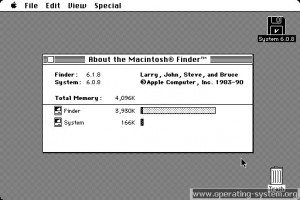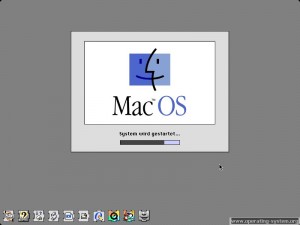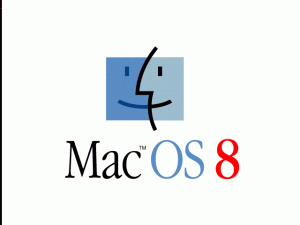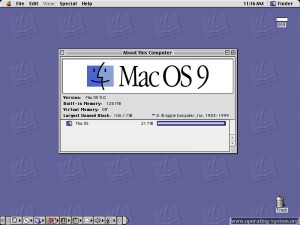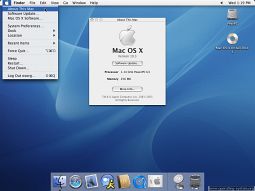Apple first introduced its Macintosh Personal computer in January 24, 1984. The software used in the computer was first named as “Mac System Software.” The name was later changed to “Mac OS” after the introduction of 7.5. Mac OS gained popularity due to the intelligent use of graphical interface. All in all, the interface is very facile to operate and does not need long and tiring command line interface.
A Brief Look Into The Mac OS World
The Mac OS started the journey into the desktop world with its “System 3.0.” The system was not much developed when compared to the others available at the market that time. The HFS Files system was unable to differentiate between uppercase and lowercase letters.
“System 5.0” was the first system in the Mac OS lineup which started modernizing the desktop scene. It was able to run several different programs at the same time with the integrated MultiFinder. The OS was later updated to “System 6.0.” The system was mostly in assembler mode but the partial update was also done in the Pascal format. It used a 24-bit addressing mode. System 6 also made it optional for the users to enable multi-tasking in a cooperative manner.
Afterwards, “System 7.0” for the first time introduced 32-bit addressing. This means that the powerful Mac OS can now operate more heavy programs and has more worthy memory. The update to the “System 7.5” announced the support for PowerPC architecture, for the very first time. As soon as the more advanced version, “System 7.6” was announced it was officially renamed to Mac OS.
Mac OS X first debuted around the world in 2006. The Cupertino giant has only allowed the use of Mac OS X is specific Intel-Mac systems. The more powerful versions of Mac OS X have allowed the positive use of Intel-based processors. OS X is the massive and powerful 64-bit operating system which can be swiftly used on many different processors.
Now let’s take a little deeper look into the history of Mac OS and how it emerged and boomed into the Desktop and PC world. Let’s start with the step by step advent of the OS though ages;
MAC OS SYSTEM 6
The System Software 6 appeared in the market for the first time in 1988. The OS, obviously, wasn’t as advanced as the systems we see today but it provided a good start for the Mac’s never ending success. System 6 required 1MB RAM and was able to handle up to 8MB.
The file systems of the OS were trained to organize up to 2 GByte with 65,536 files in hard disks. The applications were also provided with an option to operate with the help of Multi Finder in cooperative multitasking. As for the Word processing and other program fronts, famous software like MacWrite II, WriteNow, and Microsoft Word 4.0 were made part of the Mac System 6.
MAC OS SYSTEM 7
The next advanced part of the Mac OS called as System 7 debuted in May 1991. This system was a bit more facilitated as compared to the predecessor. The new OS required 2 MB RAM. It can also be jumped to 32-bit, depending upon the hardware used. The Virtual memory was enabled. Multi-tasking was made a default option as well as memory had no limits, unlike the previous version. The user interface was also modernized with the help of AppleScript and Balloons as symbols.
A new update to System 7 happened in 1994. It converted the OS into System Software 7.5. The new OS required at least 4 MB RAM. The system powered both Macs and Power Macintosh but had some drawbacks. The update in the System 7.5 into System 7.5.5 happened in September 1996. It solved all the issues previous update had. The 7.5.5 provided the modern amenities like Ethernet driver, Open Transport 1.1.2, and support for storage drive volumes up to 4 GB.
It was the launch of 7.6, which made thttps://mobilesiri.com/samsungs-android-6-0-1-marshmallow-beta-for-the-galaxy-s6-series-limits-the-scrolling-speed/he System Software to Mac OS in the year 1997. After a year or two, Apple allowed the Mac System Software version 7.5.3 to be downloaded freely by the public. The new 7.6 can be easily downloaded into every Mac computer. It contains 68030 processor. It supported 32-bit addressing and 24-bit addressing was removed permanently. Virtual memory and overall memory management also improved in this rendition.
MAC OS 8
Apple first launched the proper Mac OS 8 in July 1997. The minimum pre-requisites for the new OS were 32 MB RAM, a 68040 or PowerPC processor32 MB RAM and 120 MB of free disk space. The starting time of the OS and several other heavy applications also reduced. The standard browsers that we see today, like, Microsoft Internet Explorer 3.0 and Netscape Navigator 3.0 were also incorporated in the new OS. Shared files through TCP/IP network were also introduced.
Soon after, Mac OS 8.1 with the filesystem HFS+ was introduced as the default option. The disk space was less wasted and more and more space for the file saving was made part of the new OS. The maximum size for the partition of hardware was promoted to 2 TByte for all Quadra and PowerMac systems. The file system was able to easily control 2 billion files with a current file size of up to 2 GB.
The update to Mac OS 8.5 further increased the speed and size of the OS. Internet search options were allowed for the very first time. The stability of the Ethernet networks increased with the ability of AppleScript multiplied up to 5 times. The “Apple System Profiler” was made part which provided different reports regarding the use of hardware and software. New and modern application like, Open Transport 2, File Exchange 3, Finder 8.5 QuickTime Pro 3, Outlook Express 4.01, Mac OS Runtime for Java 2.0 Netscape Navigator 4.0.5, and Internet Explorer 4.01, were also announced in the new update.
The next and last in the line of Mac OS 8 was Mac OS 8.6. It needed 250 MB free disk space and 24 MB RAM to function. Support for the PowerPC G4 processor was also added with the help of new kernel. New features were incorporated which made multiprocessing and multitasking better than ever. A new function called UDF 1.5.2 permitted to read and store important information and data to DVD-RAM and read of DVD-ROM media.
MAC OS 9
The Mac OS 9 was developed under the code-name of Sonata. It launched on 23rd October, 1999. Alike all the other improvements, it also bring along some very major changes and enhancements. The new OS needed 32 MB RAM with virtual memory and a PowerPC 601 processor or higher. Depending upon the installation type, the free disk storage up to 150 or 400 MB was supported.
As compared to the previous version, 50 different features were announced. Login through voice was enabled. Encrypted storage of files was made possible. The OS was able to update itself with the help of Internet availability. Users were allowed to back up all personal passwords within the Computer with the help of one Master Password. The novel version of “Carbon” API was made available for new apps.
The applications included in the OS 9 were Open Transport 2.5, Finder 9.0, Apple data security 2.0 and Mac OS Runtime for Java 2.1.4.
MAC OS X
Mac OS X is considered as the most advanced and the most revolutionary OS by the Apple. Different new functions, features and technologies were embedded in the new OS. It is the best possible OS ever made. Novel and innovative technologies like Mach Kernel, NEXTSTEP and tools from NetBSD and FreeBSD influenced the construction of this OS with the merger of UNIX features. Mac OS X has multi-tasking features and it has new GUI Aqua the classic GUI from Mac OS 9.
The most refined version of Mac OS X came in March 2001, in the form of Mac OS X 10.0. It allowed to install 128 MB RAM (256 MB RAM starting from Mac OS X 10.3.9) and has 1.5 GB hard disk space (3.0 GByte starting from Mac OS X 10.2). It has a total of 9 GByte free space with the least of 512 MB RAM.
What OS X includes?
- graphical user interaction with the finder
- supports QuickTime/VR
- central password administration (Keychain)
- monolithic Kernel
- well proven TCP/IP Stack
- graphical representation by Quickdraw
- Read/Write FAT, FAT32, ISO9660, UDF
What OS X has in store for us?
- 32-bit or 64-bit processing
- HFS+ file system
- needs a PowerPC G3, G4 or G5
- SMP with up to 32 CPUs
- POSIX compatible
In the new Mac OS X 10.1 more improvements and changes were made. User interaction was made quicker and OpenGL performance was made better than before. Then again, Mac OS X 10.3 came with more improved functioning and new GUI in metallic scheme with more optimized finder. Access and use of different networks was made easy. The compression format ZIP was introduced. It was said that about 12 million Mac OS X user were active in October 2004.
Mac OS X 10.4 brought 200 exclusive features. The features include easy access to programs, spotlight, index based search, simplified composition of Applescripts etc. The updates Safari browser included RSS support. The QuickTime software was also updated to version 7 with the help of H.264 video codec. DVD was announced and the use of CD-ROM was made impossible.
Mac OS X 10.5, Leopard was introduced at 26.10.2007. The new version offered more than 300 new features and updates. Virtual desktops and 3D effect was made part of the new system. The “Boot Camp” which makes it possible for Windows to be downloaded on Intel supported Macs was made an official feature. The Apple Safari 3 Web was announced for Internet surfing. For the backup of important data, “Time Machine” was announced. Your data would be automatically backed up after every single hour. The security of the Mac OS was also enhanced. The use of ASLR (Address Space Layout Randomization) and Sandboxing for applications also debuted along with this rendition. UNIX was also made part, officially.
Mac OS X 10.6 was introduced long after but it did not have much changes. The new version is a Mac computer with Intel Core 2 Duo processor and 1 GB memory and 5 GB free space. The performance and stability were optimized. It supports up to 16 TByte memory. The OS is a pure 64-bit operating system with multi core processors. Limitless new categories are also the soul of new OS.
Mac OS X 10.7, Lion was another important addition to the Mac OS series. The new and enhanced features were made part of this update. The OS now required 2 GB of RAM with x86-64 CPU and 7GB hard drive. Emoji Support, Already bundled FaceTime, Full disk encryption, Auto Save, Apple Push Notification Service, iCal, iChat, Preview, Quick Time, Safari and Text Edit were among the many other features which came along with this OS.
Now comes the turn of the more improved rendition of the Mac OS, 10.8 OS X Mountain Lion. The operating System debuted many changes including malware blocking system along with the integration of iCloud services etc. The system required 8 GB internal storage, 2 GB RAM, and the support of OS X 10.6.8 (Snow Leopard) or higher. Notification Center, Game Center, Application Updates, Improved Messaging System were all the suo motto of this OS.
After the subsequent updates and promotions, Apple was still active in making its OS near to the perfect. OS X Mavericks, version 10.9 was one such testament. This update was mainly focused on improving the battery life of the devices and putting less strain on the apps. Mavericks improved versions are now available for free. It required 8 GB internal storage, 2 GB RAM, and OS X 10.6.8 (Snow Leopard) or higher to function. This update had a list of new features and specifications. Among the many advanced features were updated Mission Control, New iBooks application, Timer coalescing, New Maps application, App Nap to save battery, OpenGL 4.1 Core Profile, Serhttps://mobilesiri.com/ios-9-vs-android-marshmallow-6-0-new-version-old-rivalry/ver Message Block version 2, etc.
Next in the line was OS X Yosemite, version 10.10. The new version had almost the same requirements as its predecessors. However, it needed a Mac with Bluetooth specs to function properly. Many new separate supports, improvements and bug fixtures were separately announced in this rendition, from time to time. It improved the previous features of the Maverick version.
The final and the update we have been adoring till now is OS X El Capitan, version 10.11 which was just announced the previous year. All Macs that were capable of running Yosemite and Maverick can run this version. It emphasized on security, design, usability and performance. The maximum amount of graphics memory was added up to 1024 MB to 1536 MB on Macs with an Intel HD 4000 GPU. More new applications were made part of the OS and are currently being added too.


